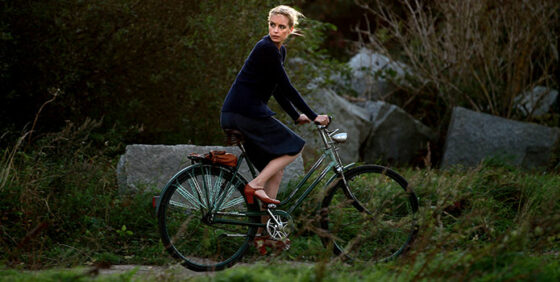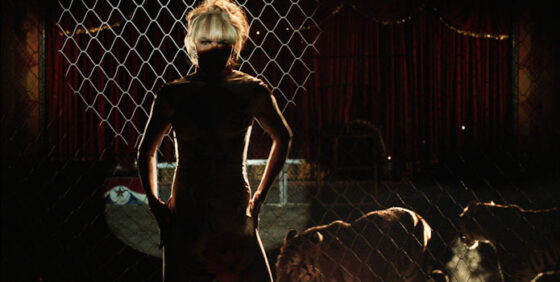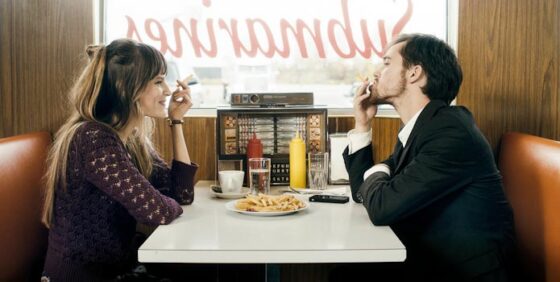TIFF Preview -6: Viola | Night Across the Street | After the Battle | Barbara | Blondie | The Last Time I Saw Macao | Liverpool | No | The Sessions | Tower | West of Memphis
Cinema Scope 52 Preview
Viola (Matías Piñeiro, Argentina)—Wavelengths
Role Models: The Films of Matías Piñeiro
By Quintín
Like most of his colleagues in recent Argentinean cinema, Matías Piñeiro is a graduate from the Universidad del Cine, and, like many of them, works outside the national funding system. Born in 1982 in Buenos Aires, Piñeiro, despite three features (El hombre robado, 2007; Todos mienten, 2009; Viola, 2012) and a 40-minute film commissioned for the Jeonju Digital Project (Rosalinda, 2011), remains overlooked. Perhaps he doesn’t draw much attention because his highly talkative movies occur in an artistic milieu (in other words, in a highly cultured environment), where, if there’s a plot at all, it’s thin or irrelevant. Nobody dies and nothing very dramatic ever happens in a Piñeiro film, which puts him definitively outside of any sort of mainstream—even the festival mainstream, which in recent years has been oriented to the intense or even the gruesome, especially when it comes to Latin American cinema.
Piñeiro’s firm sense of authorship is not grounded in bold gestures. While the complex structures of his films have been mistaken as mannerism, Piñeiro has a very distinctive style: ten seconds is enough to recognize the director’s hand. There is always a group of young women (the presence of men is somehow of secondary importance) involved in rather abstract sentimental dilemmas, occupied with talking, conquering, and cheating. Piñeiro’s characters are slightly detached from the rest of society: even his minor players are from the same age group, and likewise belong to a middle class involved in intimate, homemade art (from ringtones to poorly attended plays); they are all devoted to a kind of bohemian life. Also, they always know each other from frequenting the same haunts, and it’s as if they belong to a sect without knowing it, a secret aristocracy that creates a bond between them that is stronger than love and friendship. These people only relate to each other.
In a way, Piñeiro’s group of actors resembles a college theatre troupe, with the difference being that the quality of the acting is superb. His actresses are always more or less the same, and among them, María Villar has been raised to a sort of indie star. All of Piñeiro’s films were shot with the invaluable aid of cinematographer Fernando Lockett, who contributes elegant, refined lighting and brilliant tracking shots. Piñeiro’s films occur during daylight, with many open-air sequences, and the tone is playful: they are miles away from drama and tragedy, but also from conventional comedy. His films are very free and loose, but at the same time strict in the pace of the bodies, the camera movements, and the precision of the dialogue. Superficially, because of the tone, the presence of the same actors, and the age of the characters, these films might resemble the kind of juvenile art that the late Argentinean film wave is producing—like, for instance, the acclaimed El estudiante (2011)— but they’re moved by a much grander artistic ambition.
Piñeiro’s first feature, El hombre robado, is a comedy of twisted love affairs, featuring characters who work in a history museum from which they steal antiques; it’s somewhat Rohmerian, with a Rivettean undertone. Todos mienten, or Everybody Lies, is rather the opposite: here sentimental complications are less important than political intrigues, secret alliances, and obscure echoes of 19th-century Argentina. Both films reveal Piñeiro’s admiration of writer and politician Domingo Faustino Sarmiento, Argentina’s fourth president and a bête noir for the populist government of the Kirchners, who were already in office when Piñeiro started film school. It would be wrong to say that Piñeiro is a political filmmaker, but his work stands as an attempt to avoid the increasingly authoritarian atmosphere of the Kirchner years by suppressing all links to the omnipresent political reality and looking into a separate world: a world of art and artists, where people live their own lives and are free from the hands of the state, while they secretly long that politics might have developed in an alternative direction. The luminous texture of Piñeiro’s films may well have to do with a desire for Utopia, for a more civilized place for an artist than the country’s present circumstances. The locations in El hombre robado and in Viola (Todos mienten and Rosalinda take place in rarified spaces in the countryside) are undeniably in Buenos Aires, but the spirit comes from somewhere else.
Ghosts and echoes from the past allow Piñeiro to escape from the ordinary and to exclude or weaken the connections with the present, as if his characters are living in a void, or in a remote country. Even if people take buses or care about money, there is no daily life in Piñeiro’s films, because daily life is connected to family, to politics, to social issues, to regular jobs. Piñeiro’s people are slightly askance: they have small jobs, as if making a living is easy, or at least irrelevant. On the other hand, they are deeply concerned with their desires and with reading, acting or making music. Shakespearean comedies fit perfectly into Piñeiro’s system: the featurette Rosalinda, based on As You Like It, and Viola, based on Twelfth Night, are the first two parts of a new project. In both cases, most of the characters are actors who rehearse and play the comedy, but at the same time live their parts: the same body is used by the character in the film and by the character in the play, so the (brilliant) seduction scenes in both plays are also seduction scenes in the films. Rosalinda and Viola are not adaptations in any sense; rather, they explore what film can do with theatre as a subject and as a source, how film can expand, question and reveal theatre.
Meanwhile, the films take Shakesperean promiscuity to the limit: in the end any actor can play any character—including sex changes—as if all the bodies, the names, and all of Shakespeare’s and Piñeiro’s characters are impossible to distinguish. In Viola, María Villar plays a character named Viola who—in principle—has nothing to do with theatre. But then she meets a girl who is acting in a production of Twelfth Night who asks Viola to be her replacement. In the second act of Twelfth Night, Viola disguises herself as a man called Cesario, but in the play within the film he is called Bassanio, a character from The Merchant of Venice. Any multi-talented member of this magic sect can act, write, or even play music, as is clearly shown at the end of Viola. These endless confusions and exchanges continue on and on in the film. Piñeiro has declared that he doesn’t want to make the kind of film where characters’ paths intersect due to the cleverness of the script, but rather one that allows people to live as they want or as they can. But, in that way, all of these individualists living like monads, trying to succeed in love and art, end up mixing into a symbolic orgy, where film and theatre, men and women, music and literature, work and leisure, dating and talking, are molded into a single entity. In film after film, Piñeiro has increasingly perfected this act of magic, and Viola is his most outstanding film to date.
Night Across the Street (Raúl Ruiz, France/Chile)—Masters
By Boris Nelepo
The alarm clock that the elderly Don Celso carried around all of a sudden started ringing when he least expected it––in the middle of a translation class taught by a man named Jean Giono. The clock got so excited it ran away from its owner: it’s such a chore to chase your own possessions. While his classmates closed their eyes, Don Celso looked around. It seemed like a dream. Then the classroom became empty, alarm clocks blaring from under each table: the time was up. Don Celso’s employer decided to put him out to pasture, and a stranger named Rolo Pedro showed up on his doorstep. It wasn’t long before Don Celso realized he’d come to murder him.
Or maybe it was like this. There was a boy bizarrely named Rhododendron, who used to take Beethoven, his favourite composer and a close friend, to the movies to see adventure flicks starring Randolph Scott and Errol Flynn. One night, Long John Silver appeared, seemed to step right off the screen, and they became friends, too. The boy tells of a sudden massacre at home; then the boy will grow up to be Don Celso; then he will die.
It all boils down to the eternal question from Zhuangzi’s butterfly parable: is the dying Don Celso dreaming of his childhood, or is it a boy dreaming of his impending old age? Nestled in Raúl Ruiz’s most comfortable spot, i.e., between two worlds, the interim feel of Night Across the Street is further accentuated by the very mise en scène, as Ruiz shows in one frame parallel action taking place in two different rooms, or stages the dialogues between characters against highly stylized, early-cinema rear projections. Between the salad days and the vale of years—as in Mysteries of Lisbon (2010) or Time Regained (1999). Between the past and the present: note how defiantly the characters ignore new shopping malls and glass buildings. Between life and death, for that matter: it’s Ruiz’s farewell picture, specifically conceived to be shown after he was gone.
The way the two realities blend into one another and coexist concurrently drew Ruiz to fellow Chilean Hernán del Solar’s writings in the first place. Three of his short stories inspired the film: “Wooden Leg,” “Rhododendron,” and “La noche de enfrente.” In his home country, Solar has long been a household name in children’s literature, and is also among the co-founders of Chilean imagism. Ruiz couldn’t ask for a better match: replete with mysteries, secrets, and adventures, Solar’s books preserve an engaging sensation of ambiguity, entwining facts and fiction until it’s impossible to tell the difference.
Reiterated many a time, it soon becomes just as impossible to tell what “Rhododendron” means: a fish hanging on the wall in Don Celso’s house, his childhood nickname, or the name of the killer who is also himself. As a matter of fact, Rhododendron is a plant of the heath family; James Joyce, a well-known admirer of obscure diction, also appreciated the rolling, gleeful sound of the word. Having spent most of his life in the French countryside, Giono was yearning for Antofagasta, a place that enticed him with the melody of vowels it contains. Or so, at least, claimed Ruiz, who made the writer’s dream come true when he set his last movie there.
Antofagasta Rhododendron Atalaya de mi aljama Hotu Matu’a. Rhododendron turns into Rolo Pedro, while the ending echoes the beginning with a different flower––this time around, magnolia. In City of Pirates (1983), the gorgeous maid chanted the magical, “Atalaya de mi aljama” as the little boy (Melvil Poupaud) pricked up his ears; Hotu Matu’a was one of his many names. Just like Jean-Claude Biette, whose low-key, unassuming style Night Across the Street is most reminiscent of, Ruiz always trusted the logic of poetical concords to steer his narratives instead of turning them over to the tyranny of a сentral conflict. The latter he protested in words (Poetics of Cinema) and in deed (over a hundred films). This incantation would be incomplete without Funchalense, the name of the ship of the dead in Three Crowns of the Sailor (1983). The ghosts that sailed it badly needed a living man onboard; in Night Across the Street, Don Celso, at least temporarily, fills in as the sought-after living man surrounded by his entourage of the living, the dead, and the fictitious.
Night Across the Street is not just a comma in Ruiz’s filmography—it is the period. While many perceived Mysteries and the pataphysical Ballet aquatique (2011) as his last will and testament, Night Across the Street is the meeting point for all the wanderers who inhabited his universe. A meta-Ruizian film, it unlocks the secret recesses and false compartments of his entire oeuvre, and allows us to see it from an entirely new perspective. Hence the self-referential element: Ruiz had already adapted Giono (2001’s ambiguous Les âmes fortes); the captain from Three Crowns revered Beethoven; Adamov was an Absurdist playwright, whose play Le professeur Taranne Ruiz adapted in 1987. Such references quite vividly prove that all the books and movies you’ve absorbed remain within you, just like the late writers of yore are no worse to talk to than the regular people around you. Beethoven, who follows the protagonist everywhere, helps Ruiz make his startling point.
Stéphane Mallarmé, whose “A roll of the dice will never abolish chance” seems to underlie La noche, is also mentioned, as his poem tells, among other things, of a shipwreck and a sea captain; Ruiz was always an avid fan of all things nautical and buccaneerish. Speaking of dice, La noche is nurtured not only by wordplay, but by actual games as well: the frames are overflowing with toys and dolls, the characters play dominoes and marbles. The latter are involved in a mesmerizing homage to The Seventh Seal (1957): Don Celso, upon seeing Death, sits down to play with him––probably for the last time. The protagonist’s room is cluttered with ships in bottles; Ruiz, perhaps, made just as many films. It’s hard to come up with a better analogy for filmmaking: enclosing handmade beauty in a fragile case.
Something of a companion piece to City of Pirates, Night Across the Street borrows extensively from its predecessor: a bloodbath, an ouija-board session, a mysterious house by the seaside. The similarities between the movies, however, run much deeper. The melancholic City is imbued with a longstanding feeling of exile stemming from the author’s sad experience of leaving home against his will: Ruiz made it right after he returned for the first time to Chile after he had left for France. The garden of allegories in the film was the battlefield of ideas; the defeated had to flee. Dealing with the notions of return and homecoming, Night Across the Street is the filmmaker’s most overtly political statement in years, and also gives him a chance to travel back in time to before the dictatorship. It’s no coincidence that Sergio Hernández plays a leading role, appearing for the first time in a Ruiz film since Dialogues of Exiles (1975).
The moment he comes on screen, the 40 years that have passed no longer seem to matter. Night Across the Street acutely posits that time is non-linear, and moreover, relative in its essence. At the very beginning, as Don Celso discusses the intricacies of time with Giono, we see people behind their backs strolling backwards along the embankment, just like the waves in the opening sequence of City. Rhododendron, a very well-read boy, struggles with science and math; for every question, including the year Chile was founded, he has two answers. Ruiz defies the concepts of past and future, because the space he depicts is devoid of time altogether, which allows Stevenson’s characters to engage in casual conversations with Beethoven.
“It’s time to sleep. We are old.” These are the final words of Solar’s “Rhododendron”; the final word of Ruiz’s last film is, simply, “Cut,” said over the end credits. Death is, indeed, the ultimate cut in a series of long takes, yet Night Across the Street, with each and every frame, appoints death as the ultimate artist in charge of erasing the difference between real people and figments of imagination. As the film draws to its close, Giono, Beethoven, and Long John Silver sit around a table, watched by the cast: the living, the dead, the deader, recovered either from a dream or from the past. “Did Napoleon really exist?” Professor Taranne pondered. Never before had anyone illuminated the obvious in such a stark fashion: death renders us all confabulations, works of fiction, so that we could live on—in paperbacks, word-of-mouth stories, history textbooks; Stevenson’s characters, great composers, and Napoleon himself obtain citizenships of another world where truth and a good yarn are one. Did Raúl Ruiz really exist? Let’s hope Don Celso will send him our love.
Translated by Anton Svynarenko
After the Battle (Yousry Nasrallah, Egypt/France)—Contemporary World Cinema
By Boris Nelepo
The beginning of 2011, Tahrir Square. Hosni Mubarak makes promises of reforms, the army gives its word that the demonstrators won’t be fired upon. Suddenly, nomads charge into the peaceful crowd and provoke bloodshed. Reem, a successful city girl, incidentally meets one of the attackers, Mahmoud, a horseman. Their initial flirting turns to friendship, sorely needed by Mahmoud and his family: YouTube videos of the attack have made him a pariah even among his friends.
Yousry Nasrallah watches the video and is amazed to recognize his friends among the attackers, peaceful Bedouins whom he had filmed for a documentary. Now they’ve become pawns in a political game. First, the government provokes them into aggression, then the far more numerous protesters beat them up, and finally, the opposition extracts an advantage from the situation by conveniently converting it into a myth about Mubarak’s troops of paid supporters. Nasrallah insists that the only currency in circulation was desperation.
As the author explains, an abstract bird’s eye view of the square, with a boundless sea of thousands of human figures, became symbolic of the Tahrir Revolution. After the Battle is an attempt at scaling, at “zooming” into that sea. Nasrallah was inspired by Rossellini’s War Trilogy, with the action taking place on the streets which still bear the immediate memory of what had recently transpired. What is there to see after a revolution? One of the first and most impressive scenes in the film is a drive through one of the city neighbourhoods. The streets are empty, store fronts shut up and abandoned. What is there to do after a revolution? Perhaps have another one, to bring back what the first revolution had toppled? The lingering tempo of the film ideally corresponds with the suspended state of a revolution that wasn’t. The film is intentionally de-dramatized, it just keeps flowing smoothly. The protests continue, one government is overturned, another never elected, the protests radicalize. After the Battle was filmed without a script and was set to drift freely in an undetermined direction. Finally, life itself provided the ending: in October, a demonstration was forcibly and bloodily suppressed by the army, which released tanks to crush the peaceful crowds.
Pulsing with the live energy of street fighting, After the Battle is a political dialogue between parties that struggle to find a common language. The emancipated Reem lives in a comfy city apartment with a Mulholland Drive poster on the wall, works at an advertising agency, and is in a position to talk about the core value of democracy. Mahmoud’s clan longs for stability and wants to return to its familiar way of life. The protagonists’ attempts to meet halfway are rejected by their respective circles. A touching feature of the film is the director’s idealistic faith in the sheer possibility of dialogue. A major symbol in the film is a 16-kilometre wall erected in Nazlet El-Samman in order to block the locals’ access to the Pyramids. Mahmoud and Reem are united in their desire for the unattainable: she longs for a democratic revolution to triumph, and he for his dear pyramid, as significant to him as the water of the Nile was to his peasant ancestors. In a fatally changed world, he can climb this pyramid only in his imagination and in his feverish, possibly deathbed dreams.
Barbara (Christian Petzold, Germany)—Contemporary World Cinema
By Michael Sicinski
One of several films from this year’s Berlinale that were far more deserving of the Golden Bear than the actual winner, Barbara finds the normally austere Petzold shifting toward a more conventional, humanistically inclined art cinema. His work certainly doesn’t suffer for this broadened accessibility, and it’s guaranteed to win new converts to his cause. But whereas Petzold’s recent films such as Yella (2007) and especially Jerichow (2008) examined the lingering impact of the GDR through the lens of post-communism’s displaced nomads, Barbara is a period piece, situating his benighted characters within the terror and malaise of the East German 1980s. Dr. Barbara Wolff (Nina Hoss) has been sent from Berlin to the countryside for unspecified transgressions against the state. At her new post, she reports to Dr. Reiner (Ronald Zehrfeld), a young and talented doctor who, we learn, informs to the Stasi to keep his own mistakes from catching up with him. Barbara and her West Berliner lover (Mark Waschke) have a plan to sneak her into the West, but things get complicated. She was intent on merely marking time and passing through, but between having her apartment tossed and periodic body cavity searches, she finds herself getting personally invested in the young patients who, like her, are victims of the GDR’s neo-Stalinist tyranny. Petzold invests Barbara with a warmer, more classical look than usual; he has quite deliberately sanded down the more jagged edges of his directorial style. Nevertheless, Barbara retains the filmmaker’s clear-eyed materialism. Power and violence saturate everyday life to such an extent that they become a leaden weight in the body’s cells, an added gravity or a barely visible dust that impedes movement ever so slightly. Compare this to the sensationalism of 4 Months, 3 Weeks, and 2 Days (2007) or the bromides of The Lives of Others (2006), and Petzold’s accomplishment shines all that much more brightly.
Blondie (Jesper Ganslandt, Sweden)—Vanguard
By Mark Peranson
A failure. A clan of interchangeable and stereotypical Swedish blondies—the coke snorting model, the suffering wife and mother of two, the mid-20s trying-to-find-herself girl—gather at the old homestead for their mother’s 70th birthday celebrations, and wouldn’t you know, the lifelong resentments and grudges find a way of bubbling to the surface. And almost from the first scene, I couldn’t give a shit. Divided into three acts, bringing attention to its function as a somewhat expanded teleplay—which are interspersed by pretentious tableaux out of Wes Anderson or Lars von Trier—Jesper Ganslandt (The Ape) thinks he’s doing something like social commentary, I guess, but is instead completely wasting his time. Blondie’s problem is not that it goes over the top, because it doesn’t go far enough—but that’s precisely the point. Ganslandt has fallen prey to the third-film blahs by trying to make a slightly askance commercial art-house film, but even in pursuing this narrow-minded goal, he fails miserably. Poorly edited, overacted, poorly written, borderline sexist, and just plain totally uninteresting in any random moment, Blondie exhibits the worst qualities of European filmmaking; that it’s made in an era when the potential for cinema has been advanced by so many others, and by a director who has proven he can do more, makes this plodding, pathetic assemblage that much more disappointing. Special mention should be given to the wall-to-wall battery of grating musical accompaniment, from a score that at times rips off Bernard Hermann—well, to be fair, the whole film rips off almost everyone, Bergman and Chekhov being the most obvious—but prefers to go repeatedly to deep dark well that is The Sound of Music. Basta.
The Last Time I Saw Macao (João Pedro Rodrigues, João Rui Guerra da Mata, Portugal/France)—Wavelengths
By Mark Peranson
In real life, João Rui Guerra da Mata grew up in the former Portuguese colony of Macao, and in the hybrid work The Last Time I Saw Macao, co-directed by João Pedro Rodrigues, João Rui returns. An old friend, Candy (Cindy Scrasch), contacts him after a suspicious murder during a paintball game, saying “strange and scary things are happening.” After João Rui arrives, he finds it hard to catch up to the elusive Candy—but this gives him an opportunity to wander the streets, to the places of his childhood, places that have changed or no longer exist. Just as Macao, the city, is a blend of two cultures—Portuguese and Chinese—so Macao, the film, merges fiction and documentary together into an alien beast, a play of illusion and reality that earns comparisons to the works of the late Chris Marker. It’s a portrait of the ghostly, post-handover city in the Year of the Tiger, a journey into one’s private past, and, why not, a science-fiction film, all wrapped into one.
With its noirish voiceovers (courtesy of both João Pedro and João Rui), conspiracy plots, and focus on rituals, the film is also laced with a subtext of cinephilia. The Last Time I Saw Macao also refers to von Sternberg’s film, and its lead, Jane Russell, a kind of totem for the Joãos: the first scene of the film sees Candy performing a tantalizing show to Russell’s Macao number, “You Kill Me,” standing in front of a cage containing live tigers. (The film also answers the mystery of the red shoe from last year’s Macao night-market-set short, Red Dawn, which was dedicated to the late Russell.) The Joãos put their first showstopper up front, but, don’t worry, many more follow in this wild work, all the way to a Kiss Me Deadly-like ending that can only be called apocalyptic.
Liverpool (Manon Briand, Canada)—Special Presentation
By Helen Faradji
A nightclub in Montreal. Emilie the coat-girl (singer Stephanie Lapointe) is as asexual as can be, the kind of girl that nobody notices. Except, that is, for Thomas (Charles-Alexandre Dubé), a nerd as shy as her who is equally spooked about making the first move. These two are obviously going to hit it off—and maybe have some adventures through Montreal’s underworld. Liverpool marks the comeback of director Manon Briand (Deux secondes, 1998, La turbulence des fluides, 2001), a comeback surprisingly characterized by its attempts at looking back. Firstly to childhood: the love story is treated as a fairy tale, with low stakes and sententious dialogue, drowned in music by Ramachandra Borcar that revisits the classics (Bernard Herrmann, Danny Elfman) without any true personality of its own. But Briand also looks back to her own cinema, which, along with Denis Villeneuve’s, dominated Québec in the ’90’s. Except that the flashy, over-stylized aesthetic now feels like the work of an innovator aping one of her followers: Briand’s attempt at reinvention has certain Xavier Dolan-esque qualities (slo-mo camerawork, abundant music, retro details). Worst of all, this would-be comedy-cum-social commentary offers only the most superficial look at Québecois youth, as if the film was a magazine article trying to explain to a middle-aged audience about the hipsters in their midst—and it accordingly characterizes social media tools like Facebook and Twitter as contaminating the minds of an entire generation. Our Emilie is a “pure” heroine because she doesn’t own a computer and still reads books. Reactionary? Maybe. Naïve and outdated? Definitely.
No (Pablo Larrain, Chile/USA)—Special Presentation
By Robert Koehler
The consensus favourite in Quinzaine this year was undoubtedly Pablo Larrain’s best movie to date, No, the finale of his trilogy on Chile’s Pinochet years, preceded by Tony Manero (2008) and Post Mortem (2010). No is less important to the overall state of cinema than it is to Larrain’s career, which it charges up big time. Seeming to be at first like a star vehicle for Gael García Bernal as Rene, a kind of Don Draper of his time as a masterful TV commercial maker, No emerges as an ingenious fable on the ways that modern politics have entirely projected their message and image through television. It’s an enactment of McLuhan media theories put into practice, but (again) as a comedy. Rene’s campaign of ads to urge voters to reject a 1988 national referendum to continue Pinochet’s position as dictator is viewed by Larrain half as a lightly attuned social satire and half as documentary—Rene is a fictitious composite, but the events actually did happen, and the TV ads are real, a dazzling array of archive material revealing pop-culture attitudes that mask the fact that Chile had endured 15 years of draconian darkness, and was on the verge of signing up for more of the same.
In a Quinzaine lineup sorely lacking in visual invention or unconventional cinema grammar, Larrain’s video-drenched work stood out for its deliberately dated and even degraded imagery, informed by ’80s television styles in Latin America (which, to North American eyes, most closely recall the ’70s). From its TV-aping Academy aspect ratio, still the loveliest and most aesthetically pleasing of all big screen sizes, to its shot-on-U-matic, washed-out colour and shaky-cam, No is a direct contrast to the locked-down, 35mm widescreen images of Post Mortem, which strained from a certain self-importance. Even more, No revisits the theme of TV’s influence on the public that was so tendentiously depicted in Tony Manero, and observes the medium from the standpoint of the message-makers: Pinochet’s ad team tries to apply the massage on voters, while Rene’s team aims to prod them awake. It’s worth noting that, like nearly all the better festival films, Rene’s commercials are best when they’re funniest, which they are a good deal of the time.
The Sessions (Ben Lewin, USA)—Special Presentation
By Adam Nayman
It would be easy enough to dismiss The Sessions as John Hawkes’ Oscar bid—not that we should begrudge a talented and original actor his shot at the sort of industry recognition that no amount of guest spots on Eastbound and Down can establish. But let’s give him the benefit of the doubt and say that he took the role of Mark O’ Brien—the polio-afflicted San Francisco poet who wrote about the process of losing his virginity with a professional sex surrogate (played in the film by the already Oscar-endowed Helen Hunt)—in good faith, and as a supreme challenge. In that case, wouldn’t it be silly to hold a good performance against someone who has recently made a habit of giving them?
So I’ll give it up: Hawkes fully inhabits his physically stationary role, complicating the script’s rather cute conception of O’Brien as a twinkly-eyed sage by putting some tricky topspin on his dialogue. Hawkes is so natural that he doesn’t seem to have been directed, and whether that’s a compliment to director Ben Lewin—who hasn’t made a movie in 18 years—or its opposite, the fact is that he’s enough to keep this competently made movie watchable for its duration.
Hunt, meanwhile, is doing a sort of Waterdance redux twenty years after the fact; maybe that’s why she was cast as a woman who specializes in sexual healing. For once, though, her calculated, mannered acting is used smartly. Her character is professionally performative, and so the actress’ expected telegraphing of every emotion and sensation feels authentic enough (she also really goes for it physically, spending a significant portion of her screen time fully nude without a hint of self-consciousness). Lewin’s equations of O’Brien’s bodily weakness and the emotional and psychosexual paralysis caused by his hard-wired Catholicism are reductive, and yet the film doesn’t come down too hard on the Church in the end—which is less a case of pulled punches than an attempt to honour its real-life hero’s dedication to his faith in spite. (“I like to think that God has a sense of humour.”) Lewin even mobilizes a windswept William H. Macy as just the sort of chilled-out West Coast priest who comes over with a six-pack in hand and is okay with doling out hugs—the sort of plum supporting role that falls out of the heavens.
Tower (Kazik Radwanski, Canada)—Discovery
By Christoph Huber
One of the most intriguing—and overlooked—premieres at this year’s Locarno festival, Kazik Radwanski’s feature debut follows Derek, a 34-year-old outsider still living with his parents (who tellingly are never given names). Working odd jobs like construction, his true dream project is an animation film on which he has been working for considerable time in the basement—Derek’s presentation of his miniscule and rather ridiculous achievements so far providing a scene that’s typical of the film’s purposefully perplexing tone. Conceived mostly in uncomfortable closeness to the face and gestures of its lead actor (newcomer Derek Bogart, who finds a perfect balance between expressive and enigmatic), the in-your-face confrontation with an alienating individual has drawn comparisons to Ronald Bronstein’s Frownland (2007), and Tower has a similarly unvarnished outsider-art feel, as we witness Derek wandering the streets at night and trying to make female contact in nightclubs, taking ice-cube baths (his way of a diet, as he explains in a characteristically casual-yet-crazy telephone talk), lying compulsively, and renouncing all responsibility. This all leads to a remarkable break-up scene, all mumbling evasion, painfully protracted in its let’s-get-this-over-with-quickly embarrassment. “While you’re not feeling any pain right now, you might feel a lot of pain in the future,” Derek is warned at his dentist’s. Although unassuming, the film’s stubbornness lingers in memory and acquires a touching aspect in its commitment to a lost character that seems a warped distillation of certain Canadian traits. That Tower is a rare, uncorrupted from of regional cinema also finds expression in its central animal antagonist (and possible metaphorical double): after all, Toronto is Raccoon City.
West of Memphis (Amy Berg, USA)—Mavericks
By John Semley
TIFF’s lavish mounting of Amy Berg’s doc about the case of the West Memphis Three—complete with an onstage conversation with wrongfully convicted child killer Damien Echols, along with celebrity advocates Johnny Depp and Dixie Chick Natalie Maines—speaks nicely to the film’s narrow function. The West Memphis Three trial has already been exhaustively covered in Joe Berlinger and Bruce Sinofsky’s superb HBO-commissioned documentary trilogy Paradise Lost (1996, 2000, and 2012), which apprehended revelations in the case as they happened, kick-starting a public interest in the apparent miscarriages of justice that had West Memphis, Arkansas teenagers Echols, Jason Baldwin, and Jessie Misskelley Jr. jailed for the “cult” murder of three young boys. The Paradise Lost films are remarkable not only for their detailed investigation of the case and their dispassionate engagement with the trailer-park Gothic trappings of the community (soon to gussied up for Atom Egoyan’s forthcoming narrative feature), but for their accruing metatextual layers: each successive film becomes increasingly about the film(s) that preceded it, going over (and over) previous footage to search out new resonances and taking into account the public response to the case that the films themselves had helped to galvanize.
Though it piggybacks on the Paradise Lost pictures, while also offering some original investigative research (some of which includes turtle-bite analyses), West Of Memphis is not this kind of film; it’s the Girl With the Dragon Tattoo to Berlinger and Sinofsky’s Zodiac. With the benefit of hindsight—Echols, Baldwin, and Misskelley are now all free men, after entering some wonky guilty plea that allowed them to simultaneously maintain their innocence—West of Memphis can craft a narrative out of the stacks of interview transcripts, coroner’s reports, and testimonies Berlinger and Snifosky’s films sifted through with relative myopia. Here, raw information can be shaped into knowledge—or something like it. West of Memphis is the sleek narrative version, condensed for anyone disinclined to invest the six-plus hours it takes to work through all of Paradise Lost.
There’s a palpable bogusness in the film’s narrative, though, consistently refocusing on the valiant efforts of celebrity benefactors like Eddie Vedder, Johnny Depp, and Peter Jackson (who co-produced West of Memphis with Echols) to generate awareness about the case through T-shirts and rock-and-roll fundraisers. It’s gross, watching Vedder groan through a version of Dylan’s “The Times They Are A-Changin’” (a song whose message can be connected to something like a wrongful conviction only in the most abstract regard), or watching Henry Rollins rattle off a list of celebrities he personally knows who contributed to a West Memphis Three benefit album, or watching (repeatedly) as Echols’ crusading wife Lorri Davis (also appearing on stage at TIFF) reads reams of e-mail correspondence from Jackson and his wife Fran Walsh. Paradise Lost felt like the cinematic counterpart to all those “Free the West Memphis Three” true believers who used emerging internet technology to whip up a grassroots interest in the trial and the larger conditions of injustice, pigeonholing, and police delinquency that accounted for it. West of Memphis is the after-the-fact benefit concert: no less well-intentioned, but ultimately soppy and self-valourizing.
cscope2












